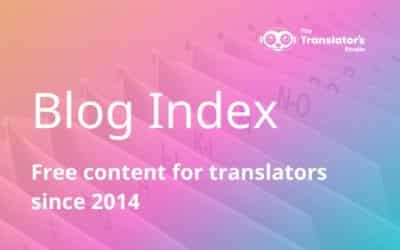If you’re planning a multilingual website, it’ll pay to think carefully about whether to have one or multiple domains. This article offers guidance to help you decide, from the perspective of translation practicalities and cost.
When you create a multilingual website, one of the first big decisions you have to make is whether to do it all on a single domain, or with a different domain for each language. For instance, imagine you want European Spanish and British English. Do you put the English version on mywebsite.co.uk and the Spanish version on mywebsite.es (multiple domains)? Or do you put both languages together at mywebsite.com (single domain)?
There are different factors to take into account, like SEO and usability. Translation is one of these factors, and it could end up involving a lot of money over the long term. This article illustrates this point by showing you what happens with translation once all the technicalities of creating your multilingual website have been resolved. It’s based on my experiences with my own websites selling translation services.
Multilingual Websites: Single or Multiple Domains?Have you thought about the impact on #translation cost of hosting your multilingual websites on single or multiple domains? This is essential reading if you haven’t.Multilingual Websites: Single… Share on XTrial and error with multilingual websites
My first translation services website was a disaster. I didn’t know how to plan it properly. Then, I cut costs by working with inexperienced developers. You name the mistake and I made it.
The finished website didn’t do what I needed it to (once I figured out what that was). About two grand out of pocket, or let’s say, two grand wiser, I approached my second website with much more care.
One of the biggest problems I hit with the first website was related to translation. The root of the issue was having both languages on the same domain. That was why I opted for two separate domains when I redid my site. Here’s what happened.
Translation for a multilingual website on a single domain
My first website had a single .com domain. The developer used a plug-in to allow multiple languages (Spanish and English). This is how it worked from the user perspective: I would create a page or blog post in the base language, which was Spanish. That would generate a URL that included “es”, e.g. www.mywebsite/services/es. I would then create a page or post containing the translation in English. That would generate a URL that ended “en”, e.g. www.mywebsite/services/en. So, I created two pages for each piece of content, one in Spanish and one in English.
When I published the pages, the two were linked together. There was a button at the top that gave visitors the option to change languages. So, when the user clicked the “EN” button, they got the English version of the page. Conversely, when they clicked the “ES” button, they got the Spanish version. When the developer explained all this to me at the start of the process, it sounded simple enough, so I said okay. While it may well have worked for many companies, I would live to regret that decision.
Good things about a single domain from a user’s perspective
– You run it all from a single user-interface, which is easier than working with two.
– Lower cost of having a single domain with single hosting.
– No messing around with multiple accounts for analytics.
– It’s easy for the user to find the translation.
– You get more visitors to the domain and this higher traffic should help SEO.
– If the website is properly developed, you should be able to perform effective SEO activities for the different languages.
Why I regretted having a single domain
Despite all the positives I’ve mentioned, I ran into a serious problem related to translation. The problem became insurmountable for me, and it was the main reason why I decided to build my second website across two domains.
If you’re planning a multilingual website, remember to think about translation costs over the long term.
The issue was each page needing an equivalent page to exist in the other language. It meant I had to translate everything. This happened because, when the user clicked “EN” or “ES”, they had to be taken somewhere. Otherwise, if nothing happened, or they got taken to the homepage, they’d think the website was broken, or get frustrated and leave.
Translating the main pages isn’t such a big deal because they’re finite. Future updates can be controlled, as I’ll explain in a later post in this series. But translating the blog can soon spiral out of control.
I blog in English and, to ensure quality in my professional translations, I translate only into my mother tongue. So, if I wanted to translate the blog, I had to pay an English-to-Spanish translator to do it. And I was producing several posts a month. I didn’t have the budget in my freelance business to pay for that.
I ended up having to create lots of pages on the blog that said “translation unavailable”. That looked rubbish for the user and wouldn’t have done me any favours for SEO.
The worst thing about it was that it was forcing me to translate content that didn’t need translating. It also limited the type of content I could create.
And what if I wanted to add French content one day? I’d then have to go back and translate everything. That could run into hundreds of pages.
Not all content needs to be translated
If you’re operating an SME, you can make your budget for SEO blog translation go further by being smart about what content you translate. For instance, imagine a real estate agent in a tourist destination in Spain. Their Spanish-speaking prospects and their English-speaking prospects won’t always need the same content. An example might be an article explaining what taxes are applicable to non-residents when they buy a property in Spain. This would be very useful for English-speaking prospects. But Spanish-speaking prospects probably wouldn’t search for this information. So, it’d make more sense to employ a bilingual content creator (like us) to produce the article and save on the translation costs. Multiply this saving by a hundred other pieces of localised content and your budget goes a lot further. Not only that, but your SEO activities get more targeted.
One of the biggest problems I hit with the first website was related to translation.
Translation for multilingual websites with multiple domains
For the reasons I’ve described, when I decided to build my second website, I wanted multiple domains. Translation wasn’t the only reason. I also wanted a .es and a .co.uk so that I could geographically target visitors in specific locations.
I now have two completely separate sites. This one, which I run with my colleague Lucy Williams. And a Spanish version, which we’re currently developing. Both websites use the same theme, colours and design. That means the user can click between them without feeling like they’re going to a different business.
The freedom this gives you is brilliant. You can create whatever content you want in each of the languages. Then, you can translate or transcreate that content if you think it’ll be of interest to the other client base. The pages on the websites can be completely different. But you can also hook articles together if you want. So, if you’ve translated an article, you can add an “ES” or “EN” button at the top. If the user clicks on it, they’ll be taken to the other website.
Good things about multiple domains from a user’s perspective
– Complete flexibility to choose between translation, transcreation, content creation or nothing.
– You can target different user locations, right down to server location.
– Option to perfect the design and content on one website before you create the second one.
– Developer can copy the design of the first website, so you don’t have to pay twice for the same work.
– You can buy another domain and create a localized website for another language further down the road without being bound by the existing content in the other languages.
The downside of having multiple domains
As you can see, the multiple-domain option works very well for Lucy and me. This is primarily because we create a large amount of content. Also, we only work with English and Spanish, so it’s easy to control. Be aware that this option involves more work, as you have to manage (at least) two separate sites. If you’re planning to create a simple site, perhaps a single domain will be easier and cheaper for your business.
A final tip on website translation
If you’re planning a multilingual website, remember to think about translation costs over the long term. Website developers may offer to organise the translation for you, but it’s better if you work directly with the translator. Translation is its own specialisation. It needs to be approached practically and not just technically. That way, you can make sure your long-term SEO-translation budget has the greatest chance of generating leads for your multilingual website.
Get our newsletter for translators!
Just put your email in the box in the sidebar and you can get all our translation tips and news sent directly to your inbox.





Hi,
very interesting post! thanks for sharing! I am wanting to create an English version of my site with a different domain and only adding some categories of my posts. So I found this extremely helpful. However I am still unsure if I need 2 different wordpress accounts if I use a plugin like WPML. Do you help with all the setting?
Thanks for reading and commenting. You won’t need two WordPress accounts if it’s the same website in different language versions.